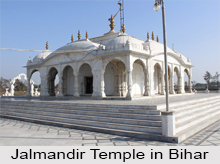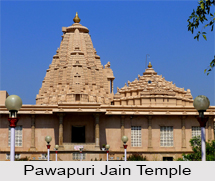 Jain temples of Bihar reveal the influence of Jains in the state. Samaveda Sikhara was constructed in 1902. This temple is a specimen of modern Jain art and architecture. The Jain Temples reveal the inherent essence of religiosity which forms the part and parcel of Shwetambara and Digambara Jain sects.
Jain temples of Bihar reveal the influence of Jains in the state. Samaveda Sikhara was constructed in 1902. This temple is a specimen of modern Jain art and architecture. The Jain Temples reveal the inherent essence of religiosity which forms the part and parcel of Shwetambara and Digambara Jain sects.
History of Jain Temples in Bihar
Eulogized in history books as the seat of many famous Indian dynasties, the Indian state of Bihar has also been the cradle of myriad religious faiths. It was in this state that Jainism, which today boasts of millions of adherents was first propagated. The chief proponent of Jain religion, Mahavira was born near Patna, capital of Bihar, in 599 BC. At very young age he became an ascetic and meditated for a long time before he became enlightened and thereafter he preached for thirty years until he attained nirvana or salvation. Today Bihar is awash with Jain relics and temples. Sadly however, many of these temples and relics have faded into the mists of time, but those that remain are testimony to the strong Jain tradition of Bihar.
Jalmandir Temple In Bihar
The most venerable Jain pilgrim spot in Bihar is the Jalmandir temple complex at Pawapuri, 60 km in the southwest of Patna. It is here that Lord Mahavira breathed his last around 500 BC and was cremated. It is said that a huge crowd had gathered to witness the funeral of the Lord, and the demand for his ashes among the mourners was so great that a colossal amount of soil was removed from around the funeral pyre resulting in the creation of a water tank. The Jalmandir, a white marble temple, in the middle of a lotus pond marks the exact spot where Lord Mahavira was cremated. There is a constant crush of devotees at this temple. It is commonly believed that by praying here a devotee loses his sins. The area around the temple is a center for curio shops and religious artifacts. Another Jain temple called Samosharan is located little away from Jalmandir.
The famous Jalmandir of Pawapuri aptly replicated in an exquisite poetry in marble at heart of Ara exudes grace and elegance. Sculptors and architects have displayed remarkable finesse in building a wonderful marble temple inside a tank, chockfull with captivating mass of lotus flowers. Within the tank is a forty feet long and four feet wide bridge, which is a gateway to the main temple premises. Enshrined within temple"s sanctum sanctorum is an intricate image of Lord Mahavira.
Shri Kundalpur Jain Temple in Bihar
Shri Kundalpur Digambar Jain Teerth Kshetra is situated in Nalanda District of Bihar nearly 4 km ahead from Nalanda Railway Station. The Teerth Kshetra is 15 km from Bihar Sharif, 15 km from Rajgir , 75 km from Gaya and 4km from Nalanda. Nearest Airport are at Patna, Bodh Gaya.
 Shri Kundalpur Digambar Jain Teerth Kshetra is the sacred place of Bhagwan Mahaveer"s Garbha, Janma & Tapa Kalyanaka. There is a huge magnificent temple with beautiful spires in Shri Kundalpur Digambar Jain Teerth Kshetra. The main Idol is an attractive Bhagwan Mahaveer"s Padmasana idol, white in color and 4 ½ feet in height is installed in this temple. There is an ancient umbrella outside the temple where foot images of Bhagwan are installed.
Shri Kundalpur Digambar Jain Teerth Kshetra is the sacred place of Bhagwan Mahaveer"s Garbha, Janma & Tapa Kalyanaka. There is a huge magnificent temple with beautiful spires in Shri Kundalpur Digambar Jain Teerth Kshetra. The main Idol is an attractive Bhagwan Mahaveer"s Padmasana idol, white in color and 4 ½ feet in height is installed in this temple. There is an ancient umbrella outside the temple where foot images of Bhagwan are installed.
Other Jain Temples in Bihar
Bahubali Jain temple is similar to the statue at Shravanbelagola temple at Mysore. This temple is situated at Shahabad district of Bihar. Bahubali Jain temple has a 15` high statue of Shri Bahubali Swami. The statue in the temple is over an artificial hillock. There are exquisite engravings of flowers, fruits and creepers round the temple.
Mahavir swami, the last Tirthankara had his Samadhi in Pawapuri in Patna district. An exquisite temple has been built inside a tank which has an attractive mass of lotus flowers. The late Abhoy Kumar Jain of Arrah conceived the idea of reproducing the Pawapuri temple in Arrah. This temple is a miniature Pawapuri temple. There is a 40` long bridge with a width of 4` for reaching the temple. It also has a fine image of Mahavir Swami.
There are 52 small Chaityalayas in Nandeswar Dwip Mandir temple. Sahasra Kuta Chaitalya temple is under the Adinath temple in Dhanpura, a suburb of Arrah town. There are 1000 Jain Arhat images that have been installed in this temple. Jain iconography can be seen here completely. The late Makhanlal Jain had Shri Adinath temple built at Dhanpura with the images of Lord Adinath, Parasnath and others. Panchayati Jain Mandir is the result of the combined efforts of the Jains of Arrah. One thousand Jain images have been carved in one stone piece. Several important relics have been collected and preserved here. Several of Jain pilgrims and non-Jain visit this temple every year.
The late Sukhanath Jain constructed Chaubishi Jain temple. There are 24 images of the Tirthankaras which are of similar colour as mentioned in Jain Agams.
Importance Of Rajgir In Bihar
Rajgir, or Rajgriha, meaning "royal abode" was the capital of Magadha Empire in 6th century BC. Situated close to Pawapuri and Nalanda, myriad historical reasons make it a holy place of prime importance for Jains. Lord Mahavira is believed to have taught here for 14 rainy seasons, many of his earliest disciples died here; also, Muni Suvarata, the 20th Jain Tirthankara, was born here. Contemporary Rajgir is a well known center for Jainism, it lies just north of the ancient site that spreads over seven barren hills- Vaibhara, Ratna, Saila, Sona, Udaya, Chhatha, and Vipula- surrounding a valley: an area that is a virtual treasure trove of earliest Jain holy places. It is littered with ruins of ancient temples and caves that offer an amazing insight into the past glories of Jainism. On Ratna hill, there are foot-idols of Neminath, Parshvanath Abhinandan Swami, Chandraprabha and Shantinath. At the foot of Vaibhara Hill are Jain temples built around 22 hot springs (kunds), which function as public baths. Here devotees or tourists can unwind in the hot emerald-green waters, that constantly bubble and sizzle from the bowels of earth. Shwetambar and Digambar temples located in Rajgir town, are adorned with ancient and artistic idols, which are worth seeing.
Importance of The Place Arra For Jains
Arra, situated 61 km from Patna, is another stronghold of Jainism in Bihar. Many ancient Jain relics, artifacts and images excavated around Arra show that Jainism flourished here as far back as 6th century AD. During the past few decades Jains of Arra have been lavishly religious and because of their efforts this area now boasts of more than 40 Jain temples, which act as magnet for tens of thousands of pilgrims every year. Some of these modern Jain temples are replicas of ancient Jain temples elsewhere and no expense seems to have been spared in constructing them.
Excavations in Nalanda- 90 km form Patna- has thrown up many archeological gems, which aptly chronicle this town"s historic links with Jainism. Once there had been a monastic university at Nalanda where Lord Mahavira used to teach, however all that today remains is ruins, which have many stories to tell. In Patna there is a Shwetambar temple and five Digambar temples. Patna museum is a good place to find ancient Jain artifacts, relics and images unearthed in various archeological diggings across Bihar. Apart from the Jain temples, there are various other Jain cultural institutions and a library, known as Jain Siddhanta Bhawan. This was established in 1905 by Shri Deo Kumar Jain. There are few charitable dispensaries, dharamshalas, a Jain High School and a Degree College named after Haraprasad Das Jain. The Jains of Arrah have been able to revive the lost glory of Shahabad district as a centre of Jain pilgrimage.











